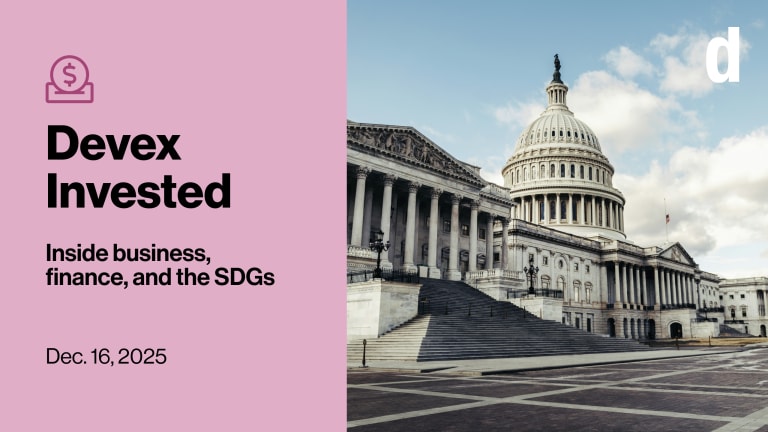A deeper look at the new DFC Impact Quotient system
The U.S. International Development Finance Corporation's new impact measurement system is complex. Here's a look at the details and what experts make of it.
WASHINGTON — The U.S. International Development Finance Corporation’s Impact Quotient framework may be complex and promising, but it will not succeed without the right resources in place, experts say. The IQ system has three key pillars: economic growth, inclusion, and innovation. Within each of those is a number of potential development objectives, including job creation, inclusive supply chains, and financing structures that attract new capital. A specific project can have multiple development objectives within the same pillar or across the pillars and can get additional points if a company is more inclusive of women or if a financial structure helps build a country’s enabling environment, among other factors. It can also lose points for environmental or governance issues or if it fails to mitigate risks. A project coming up for consideration can earn an IQ score of up to 150, with any projects scoring above 112.5 deemed “highly developmental.” Projects with a score between 37.5 and 112.5 are considered “developmental,” and those scoring below 37.5 are “indeterminate” and unlikely to move forward. “Reading over this, these three broad categories … it makes you want to challenge why every project isn’t in the ‘highly developmental’ category,” said Clemence Landers, a policy fellow at the Center for Global Development. As DFC refines IQ, narrowing the range of what is considered a developmental project would be helpful, Landers said. For an agency focused on poverty reduction, most or all of the portfolio should be highly developmental, she added. About 75% of DFC’s projects could be classified as highly developmental, said Andy Herscowitz, DFC’s chief development officer. While that is fairly good, the agency should also detail how much total DFC funding goes to highly developmental projects, as many other development finance institutions assess impact based on dollars invested rather than on projects, Landers said. The IQ framework is complex but has potential, several development experts told Devex, though they noted that the key question is how it will be implemented. The International Finance Corporation — whose Anticipated Impact Measurement and Monitoring, or AIMM, system served as a model for the IQ — has dozens of people working to implement it, and it is a “heavy lift,” Landers told Devex. It is unclear if DFC, with its small staff, will have the resources to robustly implement IQ or if it will be able to rely on the U.S. Agency for International Development to help, she said. “If we expect a higher level of accountability, transparency, and reporting, then they have to have the resources to do it,” said Rob Mosbacher, former CEO of the Overseas Private Investment Corporation, DFC’s predecessor. When OPIC faced criticism, particularly over its lack of a robust monitoring program, the response was simply that the agency did not have the staff or funding to do it, he said, adding that DFC could face similar challenges. DFC does plan to add some staffers to help with IQ, Herscowitz said, but he did not specify how many or when they would be hired. OPIC was able to use funds from fees to pay for some of its impact work, but DFC’s accounting mechanisms are structured differently, so they will not be able to do so. The White House has requested more funding for the agency in fiscal year 2021. Monitoring and evaluation While there is more clarity about how IQ will be used in the investment decision-making process, questions remain about the exact ways that DFC will use the IQ scoring system to monitor projects and assess impact over time. Herscowitz said that a process is still under development and that DFC is looking to “see what we can do to balance resource requirements.” OPIC was criticized for its lack of project management and for relying on questionnaires to recipients to find out if a project was working well, Landers said. DFC could use the IQ tool to better monitor projects and ensure they are having the intended impact, especially if it can work through USAID missions, she said. This would also allow for DFC to help push course corrections. DFC does intend to have ongoing communication with clients and will not wait until a project is close to completion before checking to see where it stands on reaching its development objectives, Herscowitz said. The agency is building a dashboard that will include all the data projections, baseline data, and actual data in one place so it can easily monitor progress and identify problems to help struggling projects reach their objectives. DFC may choose to consider impact on a portfolio level and “look illustratively at a pool of projects for more in-depth analysis,” Herscowitz said. The agency should evaluate projects on a risk basis, with higher-risk countries having a more intensive monitoring program, said Conor Savoy, executive director of the Modernizing Foreign Assistance Network. “All evidence points to the fact that in lower-capacity countries and markets, the more hand-holding, the better outcome,” he said. “The earlier you learn about problems, the better the relationship and the more proactively you can hit reset.” A portfolio-level approach can make sense to create an evidentiary base and streamline projects, looking at a certain type of project and then inferring lessons to replicate success, Savoy said. It’s in the details There are also questions about process and specific metrics, including whether projects reach the poor and how the agency considers the quality — not just quantity — of jobs. While the second pillar of inclusion is meant to assess whether a project reaches the poorest or disadvantaged populations, a project could potentially not include a relevant development objective under that pillar. That led to at least one impact expert on Twitter to question whether DFC’s projects will reach the poor. When you dig into some specific metrics, like jobs, DFC takes a bit of a hybrid approach to calculating impact. While the main score evaluates the number of formal jobs that a project will create, DFC may also award bonus points if those are considered “high-quality jobs.” It defines high-quality jobs as those where a company’s voluntary initiatives provide “exemplary employee benefits, such as family-friendly and/or human capacity building benefits, and policies that advance women in the workplace.” While the IQ score can operate as a mechanism to help companies improve performance — and DFC has already gone back to companies to push them on certain factors — it will be largely asking them to make voluntary commitments. “We have plenty of requirements already in the loan documents,” Herscowitz said. “Sometimes, ancillary impacts are aspirational. We want them to achieve the aspirational goals without penalizing them.” The success of IQ will also be driven by how DFC resets institutional incentives and how staff mindsets change, he said. Whether investment officers see projects and can quickly screen out those that may not get a high IQ score, or consider how a project might boost its score, will be interesting to watch, Savoy said. “An investment officer needs to internalize and know the IQ score really well,” he said. Those concerned with transparency would like to see as much specific information as possible at the project level, but Hercowitz told Devex that the IQ score will not be publicly released. The development community needs to be able to understand where funds are going, particularly in higher-income countries, but the data is not currently disaggregated so it is hard to tell whether funding may be going to the poorest regions of an upper-middle-income country where there are great development needs, Landers said. “It’s a great opportunity for a new agency to lead the charge on transparency. Why not make the scores public?” she said.
WASHINGTON — The U.S. International Development Finance Corporation’s Impact Quotient framework may be complex and promising, but it will not succeed without the right resources in place, experts say.
The IQ system has three key pillars: economic growth, inclusion, and innovation. Within each of those is a number of potential development objectives, including job creation, inclusive supply chains, and financing structures that attract new capital.
A specific project can have multiple development objectives within the same pillar or across the pillars and can get additional points if a company is more inclusive of women or if a financial structure helps build a country’s enabling environment, among other factors. It can also lose points for environmental or governance issues or if it fails to mitigate risks.
This story is forDevex Promembers
Unlock this story now with a 15-day free trial of Devex Pro.
With a Devex Pro subscription you'll get access to deeper analysis and exclusive insights from our reporters and analysts.
Start my free trialRequest a group subscription Printing articles to share with others is a breach of our terms and conditions and copyright policy. Please use the sharing options on the left side of the article. Devex Pro members may share up to 10 articles per month using the Pro share tool ( ).
Adva Saldinger is a Senior Reporter at Devex where she covers development finance, as well as U.S. foreign aid policy. Adva explores the role the private sector and private capital play in development and authors the weekly Devex Invested newsletter bringing the latest news on the role of business and finance in addressing global challenges. A journalist with more than 10 years of experience, she has worked at several newspapers in the U.S. and lived in both Ghana and South Africa.








